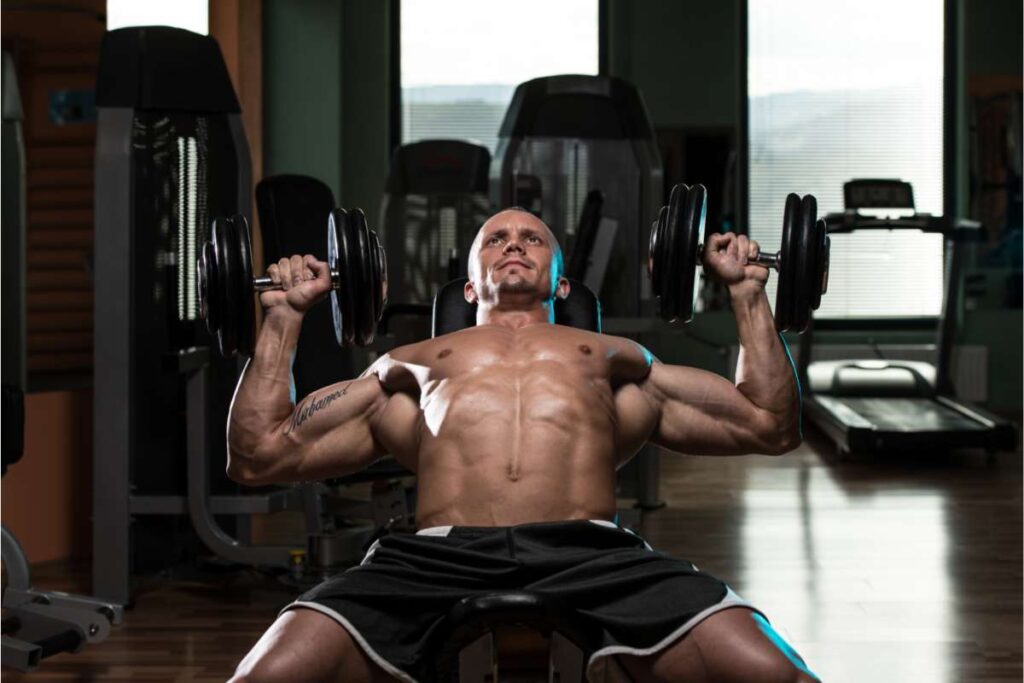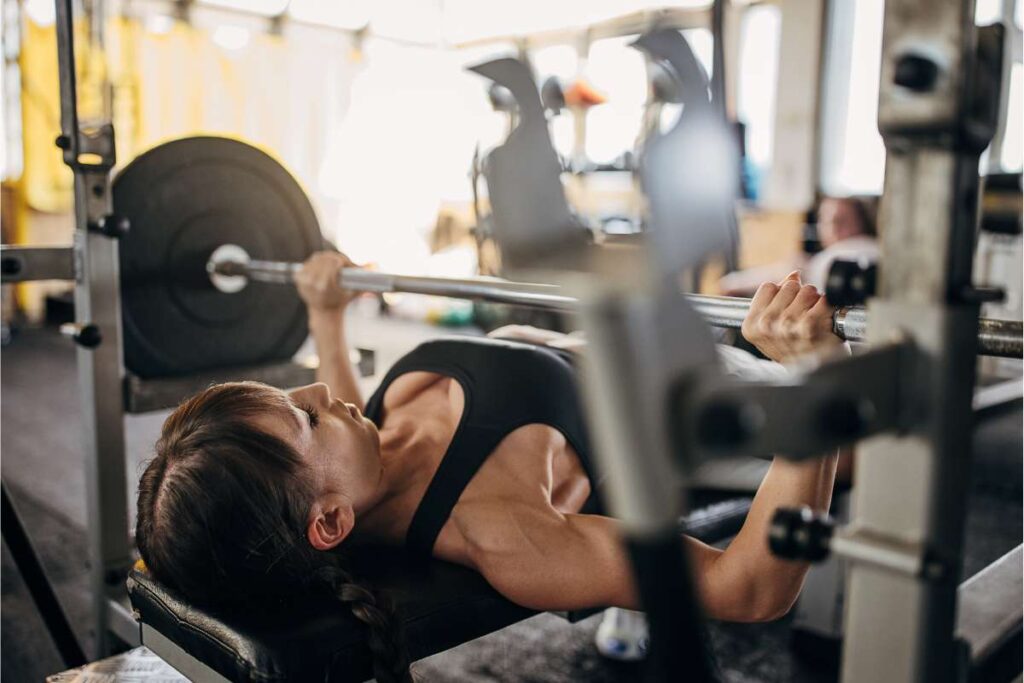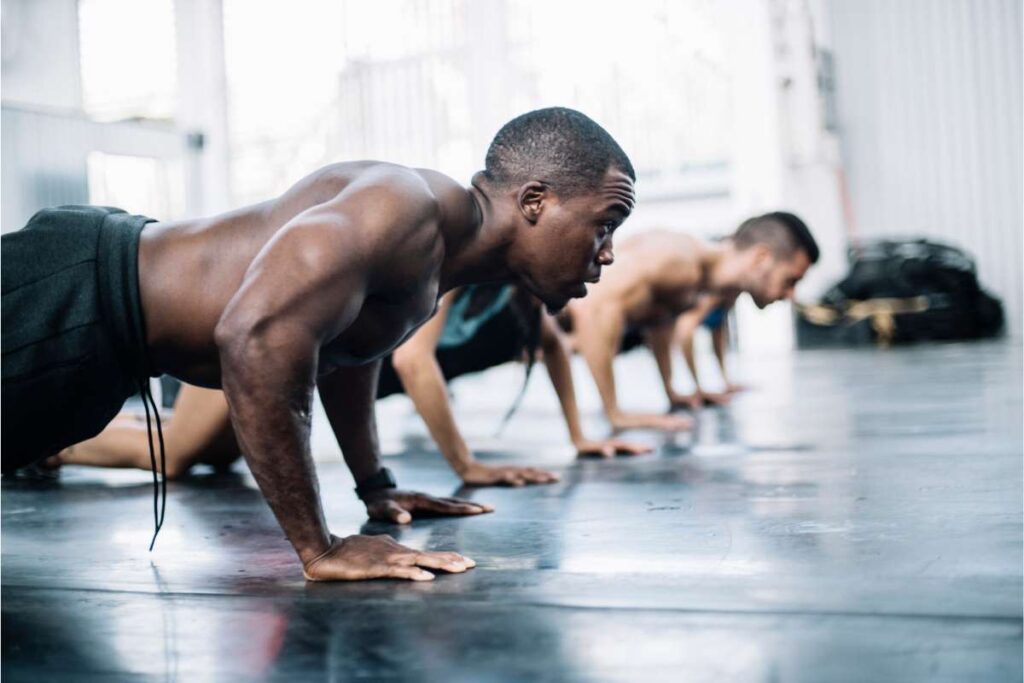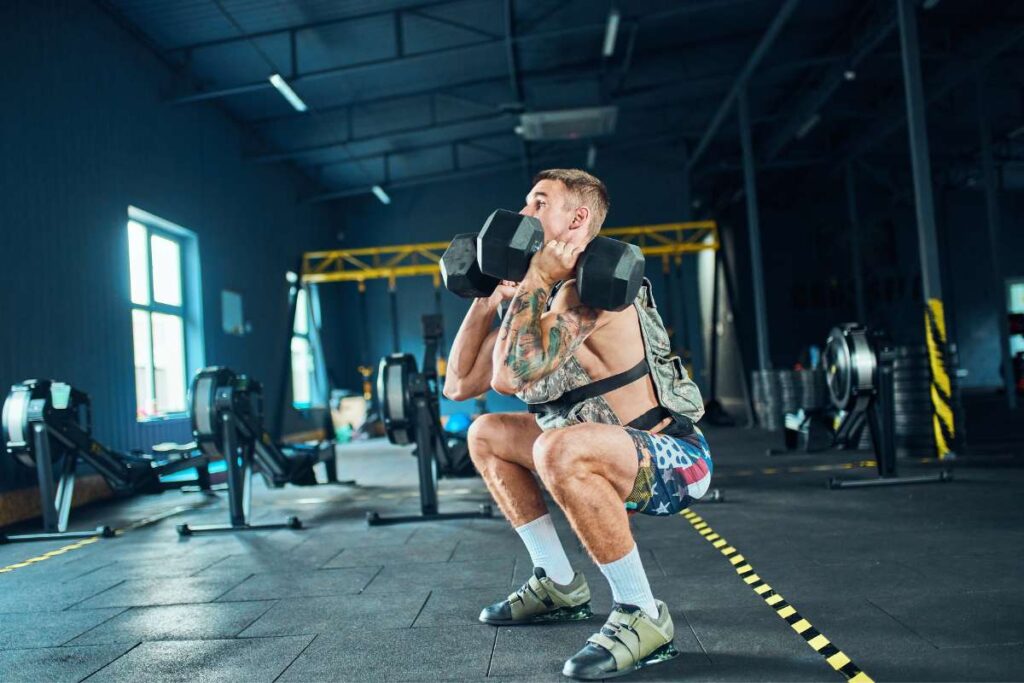This post may contain affiliate links at no additional cost to you. As an Amazon Associate I earn from qualifying purchases. Click to view our full disclosure.
What's inside
Do your push day workouts feel a little stale and uninteresting?
You have been performing the same exercises for months, the results are coming slowly, and you’re beginning to lose the motivation to keep going.
This is an issue that many of my clients have faced over my 12+ years as a personal trainer.
It’s also one I have had great success in helping them overcome. If your current program isn’t working, there are many solid ways to break through plateaus and achieve those goals.
It all starts here. Today, I’m going to give you the 10 best exercises to include in your push day workout program.
We’ll also cover the push day anatomy, common benefits, and professional tips to help you get the most out of push day workouts.
Let’s dive in.
What is a push day workout?

Push day workouts are designed to train the muscles that are involved in pushing movements.
They target the chest, shoulders, and triceps of the upper body, plus the calves, quadriceps, and glutes of the lower body. As you can see, push day is a full-body workout.
What are the major muscle groups?
There are many different muscles throughout the body that can be trained during your push day workout.
The table below illustrates the target muscles, their function, and related exercises. This is to help you get a better understanding of your anatomy and build a great mind-muscle connection that improves your results.
| Muscle | Function | Exercises |
| Pectoralis Major | Horizontally Adducts Shoulder, Adduction, Internal Rotation | Dumbbell Chest Press, Bench Press, Machine Press |
| Pectoralis Minor | Protraction, Abduction, Internal Rotation, Stabilization | Dumbbell Chest Press, Bench Press, Machine Press |
| Deltoid (Shoulders) | Shoulder Flexion | Shoulder Press, Front Raises |
| Triceps | Elbow Extension | Chest Press, Tricep Pushdown |
| Quadriceps | Hip Flexion, Knee Extension | Squats, Lunges |
| Glutes | Hip Extension, Hip Stabilization, Hip External Rotation | Hip Thrusts |
| Calves | Plantar Flexion | Standing Calf Raises, Seated Calf Raises |
What are the pushing muscles?

The pushing muscles include the chest, shoulders, triceps, quadriceps, glutes, and calves.
A great way to remember them is to imagine you are pushing a car or something heavy, and think of the muscles that would be working.
These are your push muscles.
Common Benefits of a Push Day Workout
Push day workouts strengthen the body and build lean muscle. Here’s some other common benefits that come from performing a push workout routine.
Increase Strength
Increased strength is one of the main benefits of performing a push day routine.
Scientific studies show that performing sets of one to five repetitions at 80%-100% of your one repetition maximum (1RM) is required to improve strength.
This rep range can be applied to your push workout routine to help improve strength.
Build Muscle
Building muscle mass is another huge reason you should consider performing push workouts.
Studies illustrate that performing sets of eight to 12 repetitions at 60%-80% 1RM is effective in promoting muscle hypertrophy.
By targeting your push day muscles with this configuration of reps, you challenge your body to adapt and build lean muscle mass.
Improve Physique
Improved physique is an amazing (and probably the most desired) benefit of performing push day workout routines.
Push day muscles are some of the most aesthetically pleasing in the body. This goes especially for the chest, shoulders, and triceps as they create a fullness through the upper body, giving you a defined athletic look.
Improved Function
Push day workouts include multi-joint movements typically performed as part of a push, pull, and legs training split.
Research indicates that multi-joint movements are beneficial for great physical adaptation.
Exercises that make up push day workouts such squats, bench press, and lunges replicate movements that matter beyond our workouts. Your ability to sit, reach, and lift at work or home can be improved with a solid push day.
10 Best Push Day Exercises To Include in Your Workout Program
Related: A Detailed Guide To The Best 4 Day Push Pull Workout Routine

Okay, now it’s time to get moving and build lean muscle.
Here are the best exercises to include in your push day workout routine.
1. Barbell Hip Thrust
The barbell hip thrust is designed to activate and build the glutes, which carries over to all hip hinge-based movement in the gym.
Equipment Requirements
- Bench
- Barbell
- Barbell Padding
How To Perform Barbell Hip Thrusts
- Sit down beside a bench with your shoulder blades resting on the bench and a barbell resting across your lap.
- Place feet on the floor shoulder-width apart with knees bent at a 90-degree angle.
- Begin by lifting hips up until your torso and thighs are parallel with the floor.
- Once at the top, lower back down to the floor. Repeat.
Benefits
- Improves hip strength and function
- Improve performance of other lifts
Pro Tips
- When performing the hip thrust, focus on lifting the hips up, not the core or thighs. This will ensure you get a quality glute contraction with every rep.
- At the top of each rep, pause for one second and squeeze glutes.
2. Back Squats
The back squat is the king of all lower-body push exercises as it targets the legs and glutes while also engaging the upper body.
This is an amazing exercise for building lean muscle and strength.
Equipment Requirements
- Barbell
- Weight Plates
- Squat Rack
How To Perform Back Squats
- Set the barbell up on the squat rack at shoulder height.
- Step under the squat rack and place the barbell on the belly of your traps and across the top of your shoulder blades.
- Place feet shoulder-width apart and push up with both legs to unrack the barbell.
- Take two steps back away from the rack.
- Start by leading back with the hips and lowering yourself down to the floor.
- Lower down until your knees are bent at 90 degrees.
- Push yourself back up to the starting position. Repeat.
Benefits
- Increases strength
- Builds lower body mass
Pro Tips
- Focus on breathing, inhaling when lowering and exhaling on the as you push back up.
- Initiate each rep by unhinging the hips; this will create the ideal squat mechanics.
3. Goblet Squat
The goblet squat serves as a great introduction to adding weight to your squats.
By performing this movement with just a dumbbell or kettlebell you can gradually add weight and build up your strength.
Equipment Requirements
- Dumbbell/Kettlebell
How To Perform Goblet Squats
- Hold the kettlebell in the front rack position under your chin.
- Place feet shoulder-width apart.
- Start by unhinging hips and lower down until hips are parallel with the floor.
- Once you reach this position, push back up to the starting position. Repeat.
Benefits
- Great for introducing weight to squats
- Increase muscle mass
Pro Tips
- When holding the kettlebell in the front rack position, keep elbows up at all times. This will stop the weight from dropping forward during your squat.
- When performing the squat, lower gradually and push up with both legs evenly. This helps you build symmetry and improve muscle contraction.
4. Dumbbell Walking Lunges
Dumbbell walking lunges are an excellent exercise for building your lower body’s unilateral strength and balance.
Equipment Requirements
- Dumbbells
How To Perform Dumbbell Walking Lunges
- Stand holding a dumbbell in each hand.
- Take a step forward with one leg to assume a split stance.
- Lower the rear leg directly down toward the floor until it is bent at 90 degrees.
- Push back up and step the rear leg forward to meet the lead leg.
- Alternate this movement in a walking fashion for the remaining number of sets. Repeat.
Benefits
- Improves balance
- Builds lean muscle
Pro Tips
- When performing the lunge, focus on dropping the rear knee to the floor instead of bending the front. This will help you perform the perfect lunge.
- Focus on keeping the rear foot on your toes. This will improve balance.
5. Bench Press
The bench press holds the top spot as the best upper body push movement for building muscle and increasing strength.
Designed to target the chest, shoulders, and triceps, the bench press also requires the core and lower body to engage for stability, making it a great full-body exercise.
Equipment Requirements
- Bench Press
- Barbell
- Weight Plates
How To Perform the Bench Press
- Sit down on the end of the bench and lie back with your eye line directly below the bar.
- Grab the bar with an overhand grip just wider than your shoulders.
- Push the barbell up to unrack and position it over your chest.
- Begin by bending your elbows and lowering the barbell down toward your chest.
- Lower until your elbows are bent at 90 degrees, then press the bar back up. Repeat.
Benefits
- Improves physique
- Increase upper body mass and strength
Pro Tips
- Focus on breathing, inhaling as you lower and exhaling as you push the bar back up.
- When performing the bench press, keep the core engaged and feet firmly placed on the floor. This will improve stability and strength.
6. Dumbbell Chest Press
The dumbbell chest press is great for developing strength and stability for each arm independently.
By holding a dumbbell in both hands, each side must work to support the weight and perform their own reps, which is great for building unilateral strength.
Equipment Requirements
- Dumbbell
- Bench
How To Perform the Dumbbell Chest Press
- Holding a pair of dumbbells, lie back on the bench.
- Press the dumbbells up over your chest.
- Start by bending your elbows and lowering the dumbbells down toward your chest.
- Lower until your elbows are bent at 90 degrees.
- Press back up to the starting position and repeat.
Benefits
- Builds unilateral strength
- Great for improving muscle symmetry
Pro Tips
- When pressing, focus on pushing through with your elbows. This will improve your pec activation.
- Concentrate on your breathing, inhaling as you lower and exhaling as you press.
7. Machine Chest Press
The machine chest press is a safe and effective piece of equipment for beginners introducing resistance.
It is also great for advanced lifters, allowing you to simply sit down and push for an incredible chest pump.
Equipment Requirements
- Machine Press
How To Perform the Machine Chest Press
- Sit on the machine chest press and grab a handle in each hand.
- Start by pushing the handles out in front of you until your arms are straight.
- Next, lower them back down until your elbows are bent at 90 degrees. Repeat.
Benefits
- Great introduction to weighted chest exercises
- Safe push exercise
Pro Tips
- Start with a lighter weight and focus on contracting your chest muscle. Increase weight with each set.
- Beginners should focus on tensing the core and controlling the breath. This will help prepare for more advanced chest exercises in the future.
8. Seated Dumbbell Shoulder Press
The dumbbell shoulder press is key for building huge shoulders and improving overhead strength.
Equipment Requirements
- Dumbbells
- Bench
How To Perform the Seated Dumbbell Shoulder Press
- Holding a pair of dumbbells, sit down on the end of a bench.
- Press dumbbells directly overhead so they meet at the midline of the body.
- Begin by allowing your elbows to bend out to the side.
- Lower until your elbows are bent at 90 degrees.
- Press them back up to the beginning position and repeat.
Benefits
- Improves overhead strength
- Improves physique
Pro Tips
- To avoid injury, beginners should start with a lighter weight and focus on technique.
- If you are experiencing discomfort or difficulty pressing overhead, bring your elbows in 30 degrees toward the midline to the body. This will reduce pressure in the shoulders and improve range of motion.
9. Dips
Dips are an incredible upper body push exercise that can be used to build strength and size for the chest, shoulders, and triceps.
Equipment Requirements
- Dip Bars
How To Perform Dips
- Grab a dip bar in each hand and hoist yourself off the floor.
- Start by bending your elbows and lowering yourself until your elbows are bent at 90 degrees.
- Push yourself back up to the starting position and repeat for the desired number of reps.
Benefits
- Builds upper body strength
- Increase muscle mass and improve physique
Pro Tips
- Beginners should start by performing their dips with a smaller range of motion. This will allow them to build strength.
- Keep legs straight and core engaged for the entire set. This will minimize unwanted movement and improve your ability to perform the exercise.
10. Smith Machine Calf Raises
Smith machine calf raises are a fantastic exercise for loading and building massive calves.
The machine itself has a safety locking mechanism, meaning that you can push your calves to the limit and then safely lockout at a moment’s notice.
Equipment Requirements
- Smith Machine
- Step
- Weight Plates
How To Perform Smith Machine Calf Raises
- Set up directly beneath the Smith machine barbell.
- Lift and lock the barbell to shoulder height.
- Walk under the barbell and position on the belly of the traps.
- Push up with your legs to unrack and unlock the safety hooks.
- Step up onto the step with your toes on the edge and your heels hanging off.
- Start by pushing down with your toes and lifting your heel.
- Once at the top of the movement, lower your heels down to a full stretch. Repeat.
Benefits
- Increases lower leg mass
- Builds strength
Pro Tips
- Start with a lighter weight and focus on performing the movement through the complete range of motion.
- At the top of each rep, squeeze the calf muscle to improve muscle contraction.
The Best Push Day Workout Program
Related: Top 10 Chest Stretches

So, now that we have our 10 best push day exercises, it’s time to get to the program.
The programs below come complete with exercises, reps, sets, rest times, and a weekly schedule to help you get the best results.
For reference, the following schedule will be based on a push, pull, and leg (PPL) split.
Beginner Schedule
| Mon | Tues | Wed | Thurs | Fri | Sat | Sun |
| Push | Rest | Pull | Rest | Legs | Rest | Rest |
Beginners Push Day Workout Program (Duration 35 – 40 minutes)
| Exercise | Sets | Reps | Rest |
| Barbell Hip Thrusts | 3 | 10 | 45-60 secs |
| Goblet Squats | 3 | 10 | 30-45 secs |
| Dumbbell Walking Lunges | 3 | 8 | 30-45 secs |
| Machine Chest Press | 3 | 10-12 | 30-45 secs |
| Dumbbell Shoulder Press | 3 | 8-10 | 30-45 secs |
| Smith Machine Calf Raises | 3 | 12 | 30-45 secs |
Advanced Schedule
| Mon | Tues | Wed | Thurs | Fri | Sat | Sun |
| Push | Pull | Legs | Rest | Push | Pull | Rest |
Advanced Push Day Workout Program (Duration 50 – 60 minutes)
| Exercise | Sets | Reps | Rest |
| Barbell Hip Thrust | 4 | 8 | 45-60 secs |
| Back Squats | 4 | 8 | 30-45 secs |
| Dumbbell Walking Lunges | 3 | 8 | 30-45 secs |
| Bench Press | 4 | 8 | 30-45 secs |
| Dumbbell Chest Press | 3 | 8-10 | 30-45 secs |
| Dips | 4 | 8 | 30-45 secs |
| Smith Machine Calf Raises | 3 | 20 | 30-45 secs |
Push Day Workout at Home

Getting to the gym is not always possible for all of us. Here is a push day workout at home program so you can get results wherever you go.
Push Day Workout at Home Schedule
| Mon | Tues | Wed | Thurs | Fri | Sat | Sun |
| Push | Pull | Legs | Rest | Push | Pull | Rest |
Push Day Workout at Home Program (Duration 40 – 45 minutes)
| Exercise | Sets | Reps | Rest |
| Goblet Squats | 4 | 10 | 45-60 secs |
| Dumbbell Walking Lunges | 3 | 12 | 30-45 secs |
| Push-Ups | 3 | 15-20 | 30-45 secs |
| Bench Dips | 3 | 10-12 | 30-45 secs |
| Tricep Push-Ups | 3 | 12-15 | 30-45 secs |
| Standing Calf Raises | 3 | 20 | 30-45 secs |
Pro Tips for an Effective Push Day Workout

Building muscle mass requires more than just getting in for a killer session. It also requires good nutrition and the right volume of training.
Here’s a few professional training tips to help you take your push day work to the next level.
Eat a Calorie Surplus
When we set out to build muscle, it’s important that we eat a calorie surplus to fuel our body for our push day routine.
Research recommends a daily calorie intake of 2,500 for men and 2,000 for women.
To build lean muscle we suggest adding a further 500 calories to this target.
However, these are generalized suggestions. If you want to get a more accurate rundown, try this macro calorie calculator.
Add your age, gender, height, weight, and activity level to get your specific calorie target.
Once you have this number, consider inputting it into a nutrition tracking app like MyFitnessPal. You can add your calorie target and easily track your food and macros.
Eat Enough Protein
When training to build lean muscle mass, our body needs protein to help with recovery and promote hypertrophy.
Studies recommend a daily intake of 1.6g – 2.2g of protein per kilogram of body weight.
This can be done through eating a protein-rich diet consisting of lean meat, nuts, and seeds, with additional assistance from protein supplements – such as protein shakes – to boost your protein intake.
Increase Training Volume
If you’re looking to take your push day muscles to the next level, you should consider increasing the number of days you train.
Science indicates that increasing training volume is linked to enhanced muscle hypertrophy.
This can be easily done with a split program such as push, pull, and legs where you can target each muscle group with sufficient rest between days to allow for recovery.
Progressive Overload
Progressively overloading your muscles and challenging them each session is essential for building lean body mass.
Studies indicate that increasing resistance gradually can help promote greater muscle hypertrophy.
This can be done by increasing sets, reps, and weight incrementally to promote new muscle adaptations.
Final Thoughts

Push day exercise routines are some of the most enjoyable sessions in the gym. However, this does not mean they are impervious to becoming repetitive.
With a little creativity, you can expand your repertoire to keep your training fresh and your mind focused on your goals.
The key is to increase training volume, progressively overload, and be patient. And as always, get enough protein.
Follow these rules, stick with them for the long haul, and the results you’ve been looking for will finally come.
So, what does your current push day look like? Is there anything you believe needs to change?
Let us know in the comments.
What’s a good push workout?
A good push workout consists of large compound movements combined with progressive overload. A push day program consisting of a variety of presses, squats, and lunges make up an effective push day workout.
Is 4 exercises enough for push day?
Yes, four exercises is enough for push day providing your workout is consistently challenging you and your body to re-adapt.
A workout consisting of barbell hips thrusts, back squats, bench press, and dips with significant weight can easily help to build muscle and improve your physique.
How many exercises should I do on push day?
The number of exercises you shoulder for push day workout should equal 35-45 minutes (five to eight exercises). However, this may differ based on the individual, their experience level, and time.
What Should I Do On Push Days?
You should perform push-based movements such as squats, lunges, bench press, and shoulder press.
These exercises strengthen push movement, while targeting muscles of the upper and lower body.

